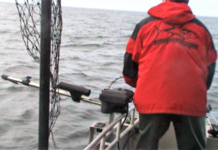
The nearly continuous, global Mid-Ocean Ridge system snakes across the Earth’s surface like the seam on a baseball. It is clearly visible on this map of global topography above and below sea level. The ridge system forms the longest and largest mountain range on Earth, winding its way between the continents.
Did You Know?
While we understand many of the basic principles that govern the phenomena of seafloor spreading, we remain in the explorative stage of this research.
By funding several expeditions to spreading centers in the Atlantic and the Pacific, the NOAA Office of Ocean Exploration and Research is helping provide a window through which to view mid-ocean ridges.
NOAA continues to draw the fascinating connections between volcanic, tectonic, hydrothermal, and biological systems in order to better understand the Earth’s remarkable, evolving geography.
The massive Mid-Ocean Ridge system wraps around the globe like seams on a baseball, stretching an impressive 65,000 kilometers (40,390 miles). The majority of the system is underwater, with an average water depth to the top of the ridge of 2,500 meters (8,200 feet).
Mid-ocean ridges are geologically important because they occur along divergent plate boundaries, where new ocean floor is created as the Earth’s tectonic plates spread apart. As the plates separate, some molten rock rises to the seafloor, producing enormous volcanic eruptions of basalt, and building the longest chain of volcanoes in the world. Because most of these eruptions occur deep under the water, they often go unnoticed.
The spreading rates of ridges vary. Some spread quite slowly, no more than one to three centimeters per year while others spread at rates approaching 10 – 20 centimeters (four to eight inches) per year. The rate of spreading influences the topography of the ridge. A slowly spreading ridge displays a steep irregular topography and is relatively narrow while a faster spreading rate produces a much wider profile and more gentle slopes.
Two of the most carefully studied mid-ocean ridges are the Mid-Atlantic Ridge and the East Pacific Rise. The Mid-Atlantic Ridge runs down the center of the Atlantic Ocean, slowly spreading at a rate of two to five centimeters (0.8 to 2 inches) per year and forming a rift valley that is about the depth and width of the Grand Canyon. In contrast, the East Pacific Rise spreads fast at rates of 6 to 16 centimeters (three to six inches) per year. Due to the fast spreading rates, there is no rift valley in the Pacific, just a smooth volcanic summit with a crack along the crest that is much smaller than the Atlantic rift valley.
Like the rest of the deep-ocean floor, we have explored less of the mountains of the Mid-Ocean Ridge system than the surface of Venus, Mars, or the dark side of the Moon. Use of submersible or remotely operated vehicles to explore the mid-ocean ridge has provided information on less than 0.1 percent of the ridge!
Despite being such prominent feature on our planet, much of the Mid-Ocean Ridge remains a mystery, which is why we will continue to explore it.
For More Information:
What Is The Mid-Ocean Ridge? ~ GalAPAGoS: Where Ridge Meets Hotspot
Mid-Ocean Ridges ~ Multimedia Discovery Missions
Submarine Ring of Fire 2012: NE Lau Basin
Galápagos Rift Expedition 2011
Submarine Ring of Fire 2003 – Mariana Arc
Sign up for the Ocean Explorer E-mail Update List.














